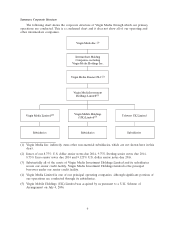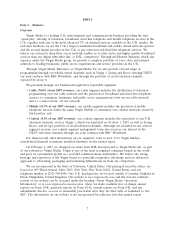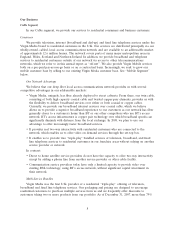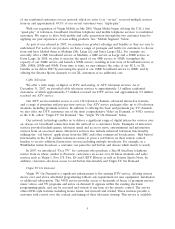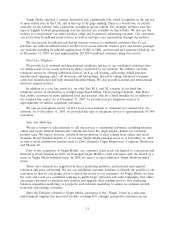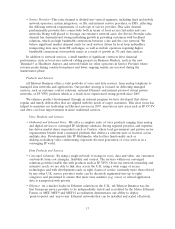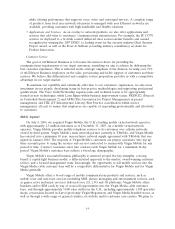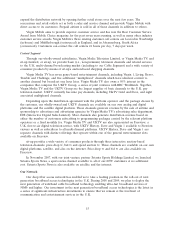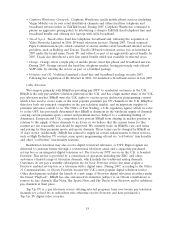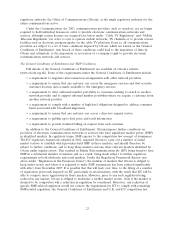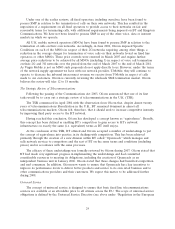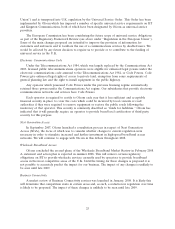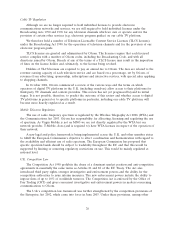Virgin Media 2007 Annual Report Download - page 18
Download and view the complete annual report
Please find page 18 of the 2007 Virgin Media annual report below. You can navigate through the pages in the report by either clicking on the pages listed below, or by using the keyword search tool below to find specific information within the annual report.Our network in the U.K. currently passes approximately 12.6 million homes in our regional service
areas as well as passing a significant number of businesses in these areas. Our service areas include
parts of many of the major metropolitan areas in the U.K., including Belfast, Birmingham, Bradford,
Brighton, Bristol, Cambridge, Cardiff, Coventry, Derby, Dundee, Edinburgh, Exeter, Glasgow, Leeds,
Leicester, Liverpool, London, Manchester, Newcastle, Nottingham, Oxford, Perth, Plymouth,
Portsmouth, Reading, Sheffield, Southampton, Swansea and Teesside.
The core network has a fiber backbone that is approximately 23,000 kilometers long. This includes
over 15,500 kilometers which are owned and operated by us and approximately 7,500 kilometers which
are leased fiber from other network owners. Over 157 switches direct telephone traffic around the core
and local networks. In addition, we have more than 600 hub sites, points of presence, repeater nodes or
other types of network sites, and facilities at over 140 radio sites.
Our deep fiber access network delivers broadband, fixed line telephony and both digital and analog
television services to our customers’ homes. The connection into each home from the fiber access
network comprises of two components combined into a single ‘‘siamese’’ drop cable. First, to provide
television services and high-speed broadband internet access, we make use of a high capacity, two-way,
coaxial cable which has considerable bandwidth and is able to support a full portfolio of linear and on
demand TV services as well as ultra-fast broadband services. Second, we use short length twisted
copper-pair to economically connect fixed line telephony services to our fiber access network via
primary multiplexers. Our relatively short twisted copper pairs (typically 500 meters in length) are also
capable of supporting the latest VDSL2 copper broadband technologies enabling speeds of 50Mb/s
downstream and 10Mb/s upstream. This capability provides us with a structural advantage over
traditional all copper local distribution networks, which are typically 3,250 meters in length, and are
only capable of supporting the previous generation of ADSL and ADSL2+ broadband technologies
which are both slower and much less capable in the upstream.
Because of the extensive use of fiber in our access networks, we are also able to provide
high-speed ethernet services directly to business customers and provide nationwide area networking to
these customers via our core networks.
We have a variety of alternative methods to connect our national telecommunications network over
the ‘‘last mile’’ to the premises of those customers that are located outside of our cabled areas,
including:
• we obtain permits to construct telecommunications networks and build out our network to reach
our customers. Although this is often the most costly means of reaching a customer, the expense
can be justified in the case of larger customers, or where a significant level of traffic is obtained
from a customer; and
• we lease circuits and DSL connections on the local networks of other service providers to
connect to our customers’ premises. Although this may reduce the operating margin on a
particular account, it requires significantly less capital expenditure than a direct connection, can
often be put into place relatively quickly, and can be replaced with a direct connection at a later
date if traffic volumes justify doing so.
Nationally, approximately 94% of the homes passed by our cable network can receive all of our
broadband, digital television and fixed line telephone services. We cannot however currently provide all
three of the main services on some older parts of the network. In 2007, we completed a cable network
upgrade program targeting more than half a million homes in the London area, where there was an
older, less robust cable network. These homes can now be offered broadband, interactive digital
television and fixed line telephone services.
16


